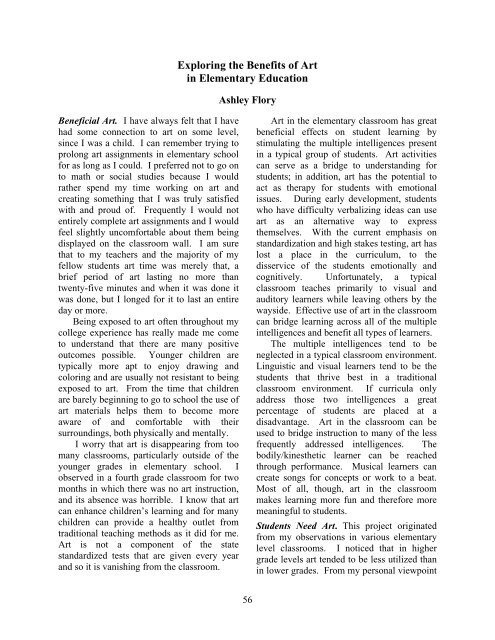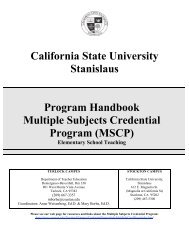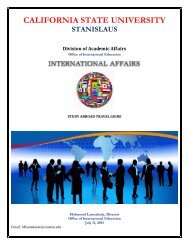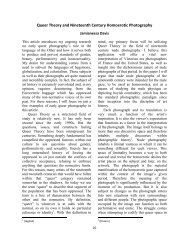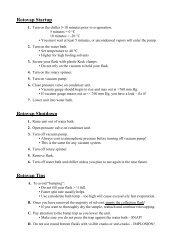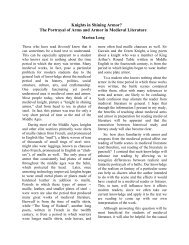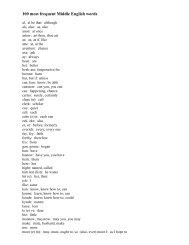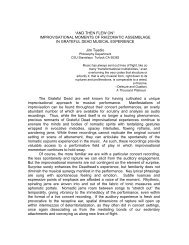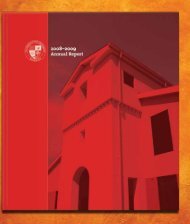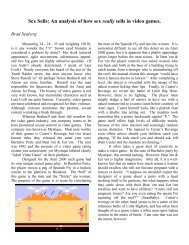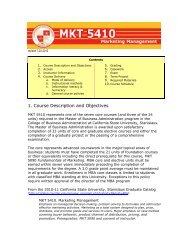Exploring the Benefits of Art in Elementary Education
Exploring the Benefits of Art in Elementary Education
Exploring the Benefits of Art in Elementary Education
Create successful ePaper yourself
Turn your PDF publications into a flip-book with our unique Google optimized e-Paper software.
Beneficial <strong>Art</strong>. I have always felt that I have<br />
had some connection to art on some level,<br />
s<strong>in</strong>ce I was a child. I can remember try<strong>in</strong>g to<br />
prolong art assignments <strong>in</strong> elementary school<br />
for as long as I could. I preferred not to go on<br />
to math or social studies because I would<br />
ra<strong>the</strong>r spend my time work<strong>in</strong>g on art and<br />
creat<strong>in</strong>g someth<strong>in</strong>g that I was truly satisfied<br />
with and proud <strong>of</strong>. Frequently I would not<br />
entirely complete art assignments and I would<br />
feel slightly uncomfortable about <strong>the</strong>m be<strong>in</strong>g<br />
displayed on <strong>the</strong> classroom wall. I am sure<br />
that to my teachers and <strong>the</strong> majority <strong>of</strong> my<br />
fellow students art time was merely that, a<br />
brief period <strong>of</strong> art last<strong>in</strong>g no more than<br />
twenty-five m<strong>in</strong>utes and when it was done it<br />
was done, but I longed for it to last an entire<br />
day or more.<br />
Be<strong>in</strong>g exposed to art <strong>of</strong>ten throughout my<br />
college experience has really made me come<br />
to understand that <strong>the</strong>re are many positive<br />
outcomes possible. Younger children are<br />
typically more apt to enjoy draw<strong>in</strong>g and<br />
color<strong>in</strong>g and are usually not resistant to be<strong>in</strong>g<br />
exposed to art. From <strong>the</strong> time that children<br />
are barely beg<strong>in</strong>n<strong>in</strong>g to go to school <strong>the</strong> use <strong>of</strong><br />
art materials helps <strong>the</strong>m to become more<br />
aware <strong>of</strong> and comfortable with <strong>the</strong>ir<br />
surround<strong>in</strong>gs, both physically and mentally.<br />
I worry that art is disappear<strong>in</strong>g from too<br />
many classrooms, particularly outside <strong>of</strong> <strong>the</strong><br />
younger grades <strong>in</strong> elementary school. I<br />
observed <strong>in</strong> a fourth grade classroom for two<br />
months <strong>in</strong> which <strong>the</strong>re was no art <strong>in</strong>struction,<br />
and its absence was horrible. I know that art<br />
can enhance children’s learn<strong>in</strong>g and for many<br />
children can provide a healthy outlet from<br />
traditional teach<strong>in</strong>g methods as it did for me.<br />
<strong>Art</strong> is not a component <strong>of</strong> <strong>the</strong> state<br />
standardized tests that are given every year<br />
and so it is vanish<strong>in</strong>g from <strong>the</strong> classroom.<br />
<strong>Explor<strong>in</strong>g</strong> <strong>the</strong> <strong>Benefits</strong> <strong>of</strong> <strong>Art</strong><br />
<strong>in</strong> <strong>Elementary</strong> <strong>Education</strong><br />
Ashley Flory<br />
56<br />
<strong>Art</strong> <strong>in</strong> <strong>the</strong> elementary classroom has great<br />
beneficial effects on student learn<strong>in</strong>g by<br />
stimulat<strong>in</strong>g <strong>the</strong> multiple <strong>in</strong>telligences present<br />
<strong>in</strong> a typical group <strong>of</strong> students. <strong>Art</strong> activities<br />
can serve as a bridge to understand<strong>in</strong>g for<br />
students; <strong>in</strong> addition, art has <strong>the</strong> potential to<br />
act as <strong>the</strong>rapy for students with emotional<br />
issues. Dur<strong>in</strong>g early development, students<br />
who have difficulty verbaliz<strong>in</strong>g ideas can use<br />
art as an alternative way to express<br />
<strong>the</strong>mselves. With <strong>the</strong> current emphasis on<br />
standardization and high stakes test<strong>in</strong>g, art has<br />
lost a place <strong>in</strong> <strong>the</strong> curriculum, to <strong>the</strong><br />
disservice <strong>of</strong> <strong>the</strong> students emotionally and<br />
cognitively. Unfortunately, a typical<br />
classroom teaches primarily to visual and<br />
auditory learners while leav<strong>in</strong>g o<strong>the</strong>rs by <strong>the</strong><br />
wayside. Effective use <strong>of</strong> art <strong>in</strong> <strong>the</strong> classroom<br />
can bridge learn<strong>in</strong>g across all <strong>of</strong> <strong>the</strong> multiple<br />
<strong>in</strong>telligences and benefit all types <strong>of</strong> learners.<br />
The multiple <strong>in</strong>telligences tend to be<br />
neglected <strong>in</strong> a typical classroom environment.<br />
L<strong>in</strong>guistic and visual learners tend to be <strong>the</strong><br />
students that thrive best <strong>in</strong> a traditional<br />
classroom environment. If curricula only<br />
address those two <strong>in</strong>telligences a great<br />
percentage <strong>of</strong> students are placed at a<br />
disadvantage. <strong>Art</strong> <strong>in</strong> <strong>the</strong> classroom can be<br />
used to bridge <strong>in</strong>struction to many <strong>of</strong> <strong>the</strong> less<br />
frequently addressed <strong>in</strong>telligences. The<br />
bodily/k<strong>in</strong>es<strong>the</strong>tic learner can be reached<br />
through performance. Musical learners can<br />
create songs for concepts or work to a beat.<br />
Most <strong>of</strong> all, though, art <strong>in</strong> <strong>the</strong> classroom<br />
makes learn<strong>in</strong>g more fun and <strong>the</strong>refore more<br />
mean<strong>in</strong>gful to students.<br />
Students Need <strong>Art</strong>. This project orig<strong>in</strong>ated<br />
from my observations <strong>in</strong> various elementary<br />
level classrooms. I noticed that <strong>in</strong> higher<br />
grade levels art tended to be less utilized than<br />
<strong>in</strong> lower grades. From my personal viewpo<strong>in</strong>t
it seemed that this deficiency was detrimental<br />
to <strong>the</strong> learn<strong>in</strong>g environment. I found that<br />
students who had difficulty express<strong>in</strong>g<br />
<strong>the</strong>mselves verbally or through writ<strong>in</strong>g could<br />
express <strong>the</strong>mselves magnificently through<br />
illustration. This was particularly evident at<br />
<strong>the</strong> k<strong>in</strong>dergarten level. Over <strong>the</strong> past three<br />
years I have done over one hundred hours <strong>of</strong><br />
observation <strong>in</strong> elementary classrooms and<br />
have noticed <strong>the</strong> effectiveness <strong>of</strong> art <strong>in</strong><br />
<strong>in</strong>struction. My goal is to exam<strong>in</strong>e <strong>the</strong><br />
importance <strong>of</strong> this neglected area <strong>of</strong><br />
education.<br />
The follow<strong>in</strong>g paper is organized <strong>in</strong>to<br />
three ma<strong>in</strong> sections. In <strong>the</strong> first section I will<br />
discuss how art helps bridge understand<strong>in</strong>g <strong>of</strong><br />
difficult subjects. Next I will discuss how No<br />
Child Left Beh<strong>in</strong>d (NCLB) has crippled <strong>the</strong><br />
art curriculum to <strong>the</strong> detriment <strong>of</strong> students.<br />
Therefore, <strong>in</strong> this project, described <strong>in</strong> <strong>the</strong><br />
third section, I will show how young students<br />
can use art to express <strong>the</strong>mselves as an<br />
alternative to verbalization.<br />
Wise Eisner. Thus far <strong>in</strong> my research, I have<br />
found a considerable amount <strong>of</strong> evidence to<br />
suggest that art’s <strong>in</strong>fluence on children helps<br />
<strong>the</strong>m to better succeed academically. There is<br />
def<strong>in</strong>itely a correlation between students’<br />
<strong>in</strong>volvement with art and <strong>the</strong>ir overall<br />
academic success. There are many important<br />
elements <strong>of</strong> a child’s cognitive development<br />
that are enhanced by art. Elliot Eisner, a<br />
major advocate for <strong>the</strong> arts, created a set <strong>of</strong><br />
examples <strong>of</strong> <strong>the</strong> importance <strong>of</strong> <strong>in</strong>clud<strong>in</strong>g art <strong>in</strong><br />
schools called: Ten Reasons to Teach <strong>Art</strong>.<br />
These reasons are listed <strong>in</strong> Eisner’s book<br />
entitled The <strong>Art</strong>s and <strong>the</strong> Creation <strong>of</strong> M<strong>in</strong>d<br />
(2002). One <strong>of</strong> <strong>the</strong> most important reasons<br />
listed is one that states: “The arts teach<br />
children to make good judgments about<br />
qualitative relationships. Unlike most <strong>of</strong> <strong>the</strong><br />
curriculum <strong>in</strong> which correct answers and rules<br />
prevail, <strong>in</strong> <strong>the</strong> arts it is judgment ra<strong>the</strong>r than<br />
rules that prevail” (Eisner, 2002). This is<br />
undoubtedly one <strong>of</strong> <strong>the</strong> biggest life lessons <strong>of</strong><br />
all and it can be well taught through art.<br />
57<br />
Instill<strong>in</strong>g this quality <strong>in</strong> children at a young<br />
age will help <strong>the</strong>m <strong>in</strong> becom<strong>in</strong>g more<br />
successful adults. Be<strong>in</strong>g able to make good<br />
judgments is an essential life skill as it is<br />
necessary <strong>in</strong> <strong>the</strong> workforce, <strong>the</strong> home and <strong>in</strong><br />
society <strong>in</strong> general. Hav<strong>in</strong>g <strong>the</strong> ability to use<br />
good judgment lends itself to good decision<br />
mak<strong>in</strong>g. <strong>Art</strong> has <strong>the</strong> ability to teach essential<br />
life lessons and so it too should be an<br />
essential subject at all levels <strong>of</strong> education.<br />
Elliot Eisner has long been recognized for<br />
his role not only as a teacher, but also as an<br />
advocate for <strong>the</strong> <strong>in</strong>clusion <strong>of</strong> arts <strong>in</strong> education.<br />
I th<strong>in</strong>k that what I learned most from Eisner’s<br />
ten criteria as a whole is that <strong>the</strong>y help to<br />
show how students have <strong>the</strong> ability to atta<strong>in</strong><br />
success not only <strong>in</strong>side <strong>the</strong> classroom, but <strong>in</strong><br />
<strong>the</strong> world as well. Leav<strong>in</strong>g art out <strong>of</strong> <strong>the</strong><br />
curriculum only has <strong>the</strong> potential to hurt<br />
students’ chances later <strong>in</strong> life.<br />
<strong>Art</strong> as presented by Eisner seems to<br />
improve <strong>the</strong> social attitudes <strong>of</strong> children.<br />
Open<strong>in</strong>g <strong>the</strong> idea <strong>of</strong> creativeness and<br />
alternativeness to a child allows for greater<br />
levels <strong>of</strong> acceptance and understand<strong>in</strong>g. I<br />
th<strong>in</strong>k that it is important for students to know<br />
that not everyone th<strong>in</strong>ks exactly alike and that<br />
alternative approaches to a problem are a<br />
good th<strong>in</strong>g. Students will come with <strong>the</strong>ir<br />
own mix <strong>of</strong> learn<strong>in</strong>g patterns which can ei<strong>the</strong>r<br />
be accepted or regarded as <strong>in</strong>correct ways <strong>of</strong><br />
th<strong>in</strong>k<strong>in</strong>g.<br />
Absence <strong>of</strong> <strong>Art</strong> Encourages Standardization.<br />
As teachers we are not rais<strong>in</strong>g robots. NCLB<br />
assessment is a means <strong>of</strong> mold<strong>in</strong>g students<br />
<strong>in</strong>to standard, diligent, and ultimately<br />
unth<strong>in</strong>k<strong>in</strong>g <strong>in</strong>dividuals. If we do not embrace<br />
<strong>the</strong> teach<strong>in</strong>gs <strong>of</strong> Eisner and take <strong>in</strong>to<br />
consideration <strong>the</strong> benefits <strong>of</strong> <strong>in</strong>corporat<strong>in</strong>g art<br />
we are only sett<strong>in</strong>g students up for failure.<br />
Allow<strong>in</strong>g for multiple perspectives early <strong>in</strong><br />
education helps promote understand<strong>in</strong>g and<br />
acceptance <strong>of</strong> o<strong>the</strong>rs while also help<strong>in</strong>g to<br />
create a desire to learn. I do not th<strong>in</strong>k that it<br />
is healthy for teachers and students to have to<br />
fear <strong>the</strong> classroom because <strong>of</strong> <strong>the</strong> current
mandates that are <strong>in</strong> place. While <strong>the</strong><br />
problem <strong>of</strong> NCLB has yet to be solved, it is<br />
still important to take <strong>in</strong>to consideration <strong>the</strong><br />
positive outcomes <strong>of</strong> <strong>in</strong>tegrat<strong>in</strong>g art with<br />
every o<strong>the</strong>r subject.<br />
Recently I have learned one major benefit<br />
that art provides. Initially when I first became<br />
<strong>in</strong>terested <strong>in</strong> this subject, I felt that I wanted<br />
to describe art as a form <strong>of</strong> communication.<br />
When I watch a K<strong>in</strong>dergartener draw or pa<strong>in</strong>t<br />
or create <strong>in</strong> any way through art, <strong>the</strong>re is<br />
someth<strong>in</strong>g that happens that does not ever<br />
happen with any o<strong>the</strong>r class activity. It is like<br />
witness<strong>in</strong>g a surge <strong>of</strong> creativeness; art seems<br />
to come more naturally for young children.<br />
At <strong>the</strong> age <strong>of</strong> only four or five years old, most<br />
students are not very advanced <strong>in</strong> <strong>the</strong>ir writ<strong>in</strong>g<br />
ability. However, with art, children are able<br />
to communicate without hav<strong>in</strong>g to be very<br />
pr<strong>of</strong>icient writers. If <strong>the</strong>y can successfully<br />
communicate someth<strong>in</strong>g through art <strong>the</strong>y will<br />
be more <strong>in</strong>cl<strong>in</strong>ed to want to learn how to<br />
communicate that same message through<br />
writ<strong>in</strong>g. <strong>Art</strong> stimulates <strong>the</strong>ir m<strong>in</strong>ds and<br />
encourages <strong>the</strong>m. This can probably be<br />
traced back to <strong>the</strong> fact that <strong>the</strong>re are no<br />
def<strong>in</strong>ed rules with art; <strong>the</strong>re are no guidel<strong>in</strong>es.<br />
You cannot draw someth<strong>in</strong>g <strong>the</strong> wrong size or<br />
pa<strong>in</strong>t someth<strong>in</strong>g <strong>the</strong> wrong color and kids are<br />
very accept<strong>in</strong>g <strong>of</strong> art because art is accept<strong>in</strong>g<br />
<strong>of</strong> <strong>the</strong>m.<br />
Deborah West, an elementary school<br />
teacher, discusses art as a language <strong>in</strong> her<br />
article “An <strong>Art</strong>s <strong>Education</strong>.” She suggests we<br />
view art<br />
as a special k<strong>in</strong>d <strong>of</strong> language. It may take<br />
<strong>the</strong> form <strong>of</strong> language as we know it, as <strong>in</strong><br />
a formal critique, or it may be <strong>in</strong> <strong>the</strong> form<br />
<strong>of</strong> visual images. Ei<strong>the</strong>r way, <strong>the</strong> language<br />
<strong>of</strong> art, similar to what Pond stated, is an<br />
effective means <strong>of</strong> communication. <strong>Art</strong><br />
encompasses what is tangible and what is<br />
imag<strong>in</strong>ed, thus balanc<strong>in</strong>g realistic<br />
representation with abstraction. As artists,<br />
young children need to develop <strong>the</strong><br />
58<br />
symbolic tools <strong>of</strong> literacy <strong>in</strong> <strong>the</strong> visual arts<br />
(West, 2000).<br />
West is expla<strong>in</strong><strong>in</strong>g someth<strong>in</strong>g I myself<br />
experienced but always found difficult to<br />
express <strong>in</strong> words. The way kids could light<br />
up when start<strong>in</strong>g to draw, and <strong>the</strong> way <strong>the</strong>y<br />
automatically gravitated toward an<br />
engagement with <strong>the</strong>ir artwork, was directly<br />
<strong>in</strong> response to what art generates for <strong>the</strong>m.<br />
<strong>Art</strong> seems to help <strong>the</strong> student with <strong>the</strong>ir own<br />
comprehension <strong>of</strong> <strong>the</strong>ir surround<strong>in</strong>gs as well<br />
as to communicate <strong>the</strong>ir feel<strong>in</strong>gs to o<strong>the</strong>rs.<br />
From my observations, I have collected<br />
student draw<strong>in</strong>gs that demonstrate great<br />
artistic ability, but limited writ<strong>in</strong>g ability.<br />
Students might not understand <strong>the</strong><br />
imag<strong>in</strong>ative and literal <strong>in</strong>terpretations <strong>of</strong> <strong>the</strong>ir<br />
art, but <strong>the</strong>re is actual substance to it. A<br />
student might draw what looks like a tree, but<br />
<strong>in</strong>corporate unrealistic colors because <strong>of</strong> <strong>the</strong>ir<br />
own preference. <strong>Art</strong> allows students to<br />
simply express <strong>the</strong>mselves <strong>in</strong> a medium that is<br />
an alternative to verbal or written<br />
communication.<br />
The pro<strong>of</strong> is <strong>in</strong> <strong>the</strong> pudd<strong>in</strong>g. When th<strong>in</strong>k<strong>in</strong>g<br />
about <strong>the</strong> question “Why is it important for<br />
my child to learn about art?” I can imag<strong>in</strong>e all<br />
sorts <strong>of</strong> arguments for why art should be left<br />
out <strong>of</strong> <strong>the</strong> curriculum, but <strong>of</strong> course know that<br />
none <strong>of</strong> <strong>the</strong>se arguments are valid. These<br />
arguments exist with<strong>in</strong> <strong>the</strong> m<strong>in</strong>ds <strong>of</strong> very<br />
ignorant people who probably lacked <strong>the</strong><br />
privilege <strong>of</strong> experienc<strong>in</strong>g art when <strong>the</strong>y were<br />
children <strong>the</strong>mselves. <strong>Art</strong> is a gateway to o<strong>the</strong>r<br />
areas <strong>of</strong> learn<strong>in</strong>g. Through art, children are<br />
exposed to math and science. I know that art<br />
is <strong>of</strong>ten overlooked for all <strong>the</strong> benefits that it<br />
does have simply because people do not<br />
realize what art has to <strong>of</strong>fer. Susan Striker<br />
argues that “We tend to compartmentalize<br />
different subjects and th<strong>in</strong>k <strong>of</strong> art as be<strong>in</strong>g<br />
quite separate from writ<strong>in</strong>g or ma<strong>the</strong>matics.<br />
Children are learn<strong>in</strong>g scientific and<br />
ma<strong>the</strong>matical facts as <strong>the</strong>y work with art<br />
materials; remov<strong>in</strong>g or subtract<strong>in</strong>g clay as<br />
<strong>the</strong>y model, add<strong>in</strong>g on when <strong>the</strong>y create
constructions, experienc<strong>in</strong>g balance as <strong>the</strong>y<br />
build” (Striker, 2001). <strong>Art</strong> <strong>in</strong> itself is separate<br />
from o<strong>the</strong>r areas <strong>in</strong> that it is <strong>the</strong> only subject<br />
that can branch itself out to so many o<strong>the</strong>r<br />
subjects that require <strong>the</strong> very same skills.<br />
However, while <strong>the</strong>re are many similarities<br />
between art and its neighbor<strong>in</strong>g subjects, it<br />
should still be regarded as someth<strong>in</strong>g<br />
completely special all on its own. <strong>Art</strong> should<br />
be appreciated as it provides so much for<br />
young learners.<br />
Joan Bouza Koster also makes <strong>the</strong> claim<br />
that art lends itself to o<strong>the</strong>r areas <strong>of</strong> learn<strong>in</strong>g.<br />
In her book, Grow<strong>in</strong>g <strong>Art</strong>ists: Teach<strong>in</strong>g <strong>Art</strong> to<br />
Young Children (2005), Koster promotes <strong>the</strong><br />
view that “<strong>Art</strong> and o<strong>the</strong>r curriculum areas are<br />
<strong>in</strong>terrelated. <strong>Art</strong> enhances learn<strong>in</strong>g <strong>in</strong> o<strong>the</strong>r<br />
subjects, and activities <strong>in</strong> o<strong>the</strong>r curriculum<br />
areas extend learn<strong>in</strong>g <strong>in</strong> art” (Koster, 2005).<br />
<strong>Art</strong> truly br<strong>in</strong>gs out <strong>the</strong> best <strong>in</strong> children as it<br />
opens <strong>the</strong>ir m<strong>in</strong>ds to everyth<strong>in</strong>g else around<br />
<strong>the</strong>m. The application <strong>of</strong> art to o<strong>the</strong>r subjects<br />
provides a safety zone for students to fall<br />
back on when <strong>the</strong>y are struggl<strong>in</strong>g or to excel<br />
<strong>in</strong> when <strong>the</strong>y understand. In part due to <strong>the</strong><br />
manner <strong>in</strong> which art is graded and judged,<br />
students are more will<strong>in</strong>g to take chances with<br />
art-<strong>in</strong>clusive projects when <strong>in</strong>corporated <strong>in</strong><br />
<strong>the</strong> classroom. Teachers tend to grade art<br />
more leniently and students know this.<br />
Incorporat<strong>in</strong>g art across <strong>the</strong> curriculum can<br />
lower <strong>in</strong>hibitions and put students more at<br />
ease <strong>in</strong> particularly challeng<strong>in</strong>g subjects.<br />
While art provides ano<strong>the</strong>r language for<br />
children as well as be<strong>in</strong>g applicable to various<br />
o<strong>the</strong>r subjects, it also aids <strong>in</strong> physical<br />
development. Robert Schirrmacher argues<br />
that “<strong>Art</strong> activities provide experience and<br />
practice <strong>in</strong> develop<strong>in</strong>g and ref<strong>in</strong><strong>in</strong>g gross<br />
motor or large muscle skills. <strong>Art</strong> <strong>in</strong>volves<br />
physical and manipulative activity. While<br />
easel pa<strong>in</strong>t<strong>in</strong>g, children use <strong>the</strong>ir entire arms<br />
and upper torsos <strong>in</strong> mak<strong>in</strong>g large, sweep<strong>in</strong>g<br />
motions with pa<strong>in</strong>tbrushes” (Schirrmacher,<br />
1998). <strong>Art</strong> helps to facilitate muscle<br />
formation. O<strong>the</strong>r forms <strong>of</strong> art also<br />
59<br />
<strong>in</strong>corporate physical activity. Performance art<br />
helps students by engag<strong>in</strong>g <strong>the</strong>ir bodilyk<strong>in</strong>es<strong>the</strong>tic<br />
learn<strong>in</strong>g styles. Increas<strong>in</strong>g<br />
physical activity helps encourage memory<br />
retention as well. When students perform <strong>in</strong><br />
<strong>the</strong> classroom, not only are <strong>the</strong>y develop<strong>in</strong>g<br />
physically, but <strong>the</strong>y are also <strong>in</strong>creas<strong>in</strong>g <strong>the</strong><br />
chance that <strong>the</strong>y will remember and learn<br />
more effectively.<br />
<strong>Art</strong> Influences Student Behavior. Students I<br />
observe generally vary <strong>in</strong> <strong>the</strong>ir classroom<br />
performance. Students <strong>in</strong> classrooms<br />
<strong>in</strong>corporat<strong>in</strong>g frequent art activities tend to<br />
participate more <strong>in</strong> class. I typically see more<br />
students volunteer<strong>in</strong>g to answer questions <strong>in</strong><br />
classes that promote art. When art is left out,<br />
<strong>the</strong> students are generally more reluctant to<br />
answer questions. I th<strong>in</strong>k this can be<br />
expla<strong>in</strong>ed at least partially by some <strong>of</strong> Elliot<br />
Eisner’s <strong>in</strong>sights. Eisner argues that expos<strong>in</strong>g<br />
kids to multiple perspectives through <strong>the</strong> use<br />
<strong>of</strong> art helps <strong>the</strong>m to become more effective<br />
problem solvers. While most subjects heavily<br />
emphasized <strong>in</strong> schools do not allow for more<br />
than one correct answer, educators still expect<br />
students to answer questions correctly with<br />
ease. However, it has been my observation<br />
that teachers are <strong>of</strong>ten too critical <strong>of</strong> student<br />
answers and some children are genu<strong>in</strong>ely<br />
afraid to ask questions. I believe that <strong>in</strong> artfriendly<br />
classrooms where multiple<br />
perspectives are presented more openly and<br />
frequently, children are more likely to want to<br />
voice <strong>the</strong>ir op<strong>in</strong>ions. Children are likely to be<br />
more productive and have higher success<br />
rates if <strong>the</strong>y are encouraged to participate.<br />
Part <strong>of</strong> this success can be attributed to good<br />
question<strong>in</strong>g strategies, but also <strong>the</strong> <strong>in</strong>clusion<br />
<strong>of</strong> art <strong>in</strong> <strong>the</strong> classroom places emphasis on <strong>the</strong><br />
correctness <strong>of</strong> multiple perspectives.<br />
Clearly <strong>the</strong>re is an abundance <strong>of</strong> benefits<br />
to be had by students <strong>of</strong> all ages. While I<br />
would like to focus on younger children and<br />
<strong>the</strong>ir connection to art, I would also like to<br />
emphasize that art should be cont<strong>in</strong>ued<br />
throughout a student’s school<strong>in</strong>g. <strong>Art</strong>
stimulates <strong>the</strong> m<strong>in</strong>d, provides a means <strong>of</strong><br />
transition to o<strong>the</strong>r subjects and builds on<br />
physical development. <strong>Art</strong> truly serves as a<br />
build<strong>in</strong>g block as it leads to a student’s<br />
enhancement <strong>in</strong> <strong>the</strong> classroom and later <strong>in</strong><br />
life. Exposure to art and artistic expression<br />
contributes to <strong>the</strong> development <strong>of</strong> wellrounded<br />
<strong>in</strong>dividuals. For this reason, as a<br />
future teacher, I plan to utilize every<br />
opportunity to <strong>in</strong>corporate and <strong>in</strong>tegrate art<br />
<strong>in</strong>to my teach<strong>in</strong>g.<br />
Multiple Intelligences for All. Instruction<br />
based on Howard Gardner’s Theory <strong>of</strong><br />
Multiple Intelligences has been a staple <strong>in</strong><br />
classrooms for several decades now, but with<br />
<strong>the</strong> shift towards high-stakes test<strong>in</strong>g, <strong>the</strong> focus<br />
on Multiple Intelligences has been gett<strong>in</strong>g<br />
pushed aside. So much concentration and<br />
emphasis have been given to test-tak<strong>in</strong>g skills<br />
and address<strong>in</strong>g <strong>the</strong> massive curriculum that<br />
teachers simply cannot take <strong>the</strong> time to<br />
<strong>in</strong>clude any art projects or activities that<br />
might focus on <strong>the</strong> less-taught <strong>in</strong>telligences.<br />
These areas are not areas that can be tested<br />
and <strong>the</strong>y are consequently not on any state<br />
tests. Precious <strong>in</strong>struction time is not<br />
<strong>the</strong>refore “sacrificed” for some <strong>of</strong> <strong>the</strong>se<br />
essential areas <strong>of</strong> understand<strong>in</strong>g and students<br />
are suffer<strong>in</strong>g. Because <strong>the</strong> required<br />
curriculum is so large, teachers are pressured<br />
to move as quickly and efficiently as possible<br />
through <strong>the</strong> grade-designated material.<br />
Because <strong>of</strong> this, <strong>the</strong> arts and consequently<br />
Multiple Intelligences-related <strong>in</strong>struction are<br />
cut.<br />
Unconventional Experimentation. In one<br />
<strong>in</strong>stance, a school has seen <strong>the</strong> benefit <strong>of</strong><br />
<strong>in</strong>corporat<strong>in</strong>g multiple <strong>in</strong>telligences <strong>in</strong>to<br />
<strong>in</strong>struction and apply<strong>in</strong>g it to standardized<br />
test<strong>in</strong>g. In one Maryland school, <strong>the</strong>y decided<br />
to <strong>in</strong>corporate multiple <strong>in</strong>telligence teach<strong>in</strong>g<br />
practices school wide as a constant tool for<br />
learn<strong>in</strong>g. Their results were excellent. Jan<br />
Grenhawk, a teacher at <strong>the</strong> school notes:<br />
60<br />
In one year our students’ scores on <strong>the</strong><br />
Maryland Performance Assessment rose<br />
by 20 percent. They [<strong>the</strong> students]<br />
remembered <strong>in</strong>formation more accurately<br />
and were confident enough to use it to<br />
solve problems… They demonstrated a<br />
flexible approach to problem solv<strong>in</strong>g.<br />
They were tak<strong>in</strong>g traditional pencil-andpaper<br />
tests, but us<strong>in</strong>g a variety <strong>of</strong><br />
strategies to complete <strong>the</strong>m. Even<br />
students whom we did not consider strong<br />
readers or writers were able to use<br />
strategies we taught to write good<br />
answers. (Grenhawk, 1997)<br />
Multiple <strong>in</strong>telligences strategies that were<br />
taught helped students achieve more than<br />
simple memorization and re-gurgitation;<br />
students learned how to be true problemsolvers<br />
and critical th<strong>in</strong>kers. The <strong>in</strong>teractive<br />
and varied approaches taken toward education<br />
helped students apply <strong>the</strong>ir knowledge on <strong>the</strong><br />
standardized state tests. This <strong>in</strong>clusion,<br />
stress<strong>in</strong>g among o<strong>the</strong>r th<strong>in</strong>gs <strong>the</strong> importance<br />
<strong>of</strong> art, allowed students to actually learn<br />
<strong>in</strong>stead <strong>of</strong> to memorize and forget.<br />
The No Child Left Beh<strong>in</strong>d Act (NCLB)<br />
was enacted <strong>in</strong> 2001 after a strong push from<br />
<strong>the</strong> Bush Adm<strong>in</strong>istration. The aim <strong>of</strong> NCLB<br />
is to make all students show pr<strong>of</strong>iciency <strong>in</strong><br />
math and read<strong>in</strong>g by 2014. NCLB enforces<br />
standardized test<strong>in</strong>g as a way <strong>of</strong> assess<strong>in</strong>g<br />
student and school progress. This approach is<br />
criticized by those who believe no s<strong>in</strong>gle<br />
test<strong>in</strong>g method is ever appropriate for all -- or<br />
that accurate assessment is impossible when a<br />
s<strong>in</strong>gle measure is emphasized <strong>in</strong> this manner.<br />
Under NCLB, schools face reprimands when<br />
<strong>the</strong>ir students are not perform<strong>in</strong>g at<br />
“acceptable” levels. Many students who are<br />
presented with standardized tests are secondlanguage<br />
English learners and may lack <strong>the</strong><br />
ability to perform successfully.<br />
In one particular case reported last year,<br />
<strong>in</strong>volv<strong>in</strong>g Bailey’s <strong>Elementary</strong> School for <strong>the</strong><br />
<strong>Art</strong>s and Sciences <strong>in</strong> Virg<strong>in</strong>ia, students were<br />
rated as perform<strong>in</strong>g under state standardized
test<strong>in</strong>g requirements. The teachers and district<br />
adm<strong>in</strong>istrators for Bailey’s argue that<br />
reformed test<strong>in</strong>g protocols would more<br />
accurately show student achievement levels.<br />
Teachers at Bailey were given district<br />
approval to supplement test<strong>in</strong>g with “work<br />
portfolios” <strong>in</strong> place <strong>of</strong> read<strong>in</strong>g tests to assess<br />
<strong>the</strong>ir ESL students. The portfolios were given<br />
to a sample <strong>of</strong> 169 students. Of <strong>the</strong>se<br />
students, 97% passed, meet<strong>in</strong>g federal<br />
academic goals (US News & World Report).<br />
Improper assessment through <strong>the</strong><br />
implementation <strong>of</strong> NCLB seems to <strong>in</strong>dicate<br />
that standardized test<strong>in</strong>g is not effective.<br />
Standardized assessments tend to test only <strong>the</strong><br />
basic knowledge aspect <strong>of</strong> Bloom’s<br />
Taxonomy. None <strong>of</strong> <strong>the</strong> higher levels <strong>of</strong><br />
learn<strong>in</strong>g are really assessed <strong>in</strong> <strong>the</strong> process.<br />
This high emphasis on test<strong>in</strong>g is not really<br />
relevant to <strong>the</strong> real world. Students are not<br />
learn<strong>in</strong>g <strong>the</strong> skills that are needed for entry<br />
<strong>in</strong>to <strong>the</strong> workforce. Schools are be<strong>in</strong>g judged<br />
as <strong>in</strong> need <strong>of</strong> improvement when <strong>in</strong> reality it<br />
is NCLB that needs to be reformed. Students<br />
and teachers alike are suffer<strong>in</strong>g. Teachers are<br />
be<strong>in</strong>g seen as <strong>in</strong>competent and not qualified to<br />
teach <strong>the</strong>ir students required skills. They are<br />
forced to modify <strong>the</strong>ir teach<strong>in</strong>g <strong>in</strong> a way that<br />
prepares students for test<strong>in</strong>g. The arts are<br />
regarded as “frill” aspects <strong>of</strong> <strong>the</strong> curriculum<br />
and unnecessary.<br />
NCLB claims to be benefit<strong>in</strong>g education<br />
by attempt<strong>in</strong>g to help struggl<strong>in</strong>g students, but<br />
clearly it is not do<strong>in</strong>g so. Additionally, at <strong>the</strong><br />
same time that it is not help<strong>in</strong>g students <strong>in</strong><br />
need it is tak<strong>in</strong>g away from students who are<br />
viewed as perform<strong>in</strong>g above average. Gifted<br />
students are ignored while <strong>the</strong>ir fellow<br />
classmates are “helped.” The focus <strong>of</strong> NCLB<br />
is try<strong>in</strong>g to get fail<strong>in</strong>g students to pass<br />
standardized tests and <strong>the</strong>refore prove that<br />
teachers and schools are competent as a<br />
whole. However, NCLB is only h<strong>in</strong>der<strong>in</strong>g <strong>the</strong><br />
school system as well as <strong>the</strong> students who<br />
depend on it.<br />
61<br />
Hypocracy <strong>of</strong> No Child Left Beh<strong>in</strong>d. NCLB<br />
has cont<strong>in</strong>ued to prove that it is not<br />
contribut<strong>in</strong>g to <strong>the</strong> success <strong>of</strong> our schools. It<br />
is seen as an enemy to many teachers and<br />
future teachers like myself. Schools must<br />
expect <strong>the</strong> unexpected from <strong>the</strong>ir students<br />
s<strong>in</strong>ce NCLB requires that every student is<br />
pass<strong>in</strong>g standardized tests <strong>in</strong> every category<br />
for <strong>the</strong>ir schools to be safe from reprimand. If<br />
a school’s test scores are deemed too low <strong>the</strong><br />
school is labeled as underperform<strong>in</strong>g and<br />
fur<strong>the</strong>r action can be taken if <strong>the</strong> school does<br />
not improve.<br />
Welcome Diversity. We happen to live <strong>in</strong> a<br />
country that is full <strong>of</strong> very diverse <strong>in</strong>dividuals.<br />
Many families chose to leave <strong>the</strong>ir own<br />
countries <strong>in</strong> <strong>the</strong> hopes <strong>of</strong> f<strong>in</strong>d<strong>in</strong>g better<br />
opportunities here <strong>in</strong> <strong>the</strong> US. Many students<br />
have not had much previous academic success<br />
due to <strong>the</strong> conditions <strong>of</strong> <strong>the</strong>ir former school<br />
system. We are supposed to be <strong>the</strong> welcomed<br />
change and yet for many immigrant families it<br />
must seem like we are perpetuat<strong>in</strong>g failure.<br />
Br<strong>in</strong>g on <strong>the</strong> Tests. An article <strong>in</strong> NEA<br />
magaz<strong>in</strong>e used four schools’ data to show that<br />
NCLB is do<strong>in</strong>g noth<strong>in</strong>g but hurt<strong>in</strong>g our<br />
schools and h<strong>in</strong>der<strong>in</strong>g our students. The<br />
standardized test<strong>in</strong>g agenda that comes along<br />
with NCLB is supposedly aimed at help<strong>in</strong>g<br />
students and schools as wholes to progress.<br />
For students at Napa High school <strong>in</strong><br />
California, <strong>the</strong> tests are help<strong>in</strong>g <strong>the</strong>m to fail.<br />
Many students at Napa High are arriv<strong>in</strong>g<br />
after leav<strong>in</strong>g <strong>the</strong>ir country and culture beh<strong>in</strong>d,<br />
speak<strong>in</strong>g <strong>the</strong>ir native language. It should not<br />
be expected that <strong>the</strong>se particular students will<br />
easily pass any sort <strong>of</strong> English pr<strong>of</strong>iciency<br />
exam, but it is. Scores <strong>of</strong> <strong>the</strong> entire school are<br />
<strong>the</strong>n lowered because students who could<br />
reasonably be expected to fail are fail<strong>in</strong>g.<br />
This particular high school has been<br />
honored with awards for student achievement<br />
<strong>in</strong> dance, music and journalism classes, and<br />
has been deemed a dist<strong>in</strong>guished school.<br />
However, <strong>the</strong> effort <strong>of</strong> <strong>the</strong> school’s teachers<br />
and students is be<strong>in</strong>g completely ignored
when students from foeign countries are be<strong>in</strong>g<br />
unfairly tested. Katy Howard is an English<br />
Learner (EL) teacher at Napa High and says<br />
that many <strong>of</strong> her students come from Mexico<br />
and are tested very early after arriv<strong>in</strong>g at <strong>the</strong><br />
school. Howard claims “<strong>the</strong>y’re tested too<br />
early. They’re tested <strong>the</strong> m<strong>in</strong>ute <strong>the</strong>y arrive.<br />
Probably 60 percent <strong>of</strong> my students are not<br />
even pr<strong>of</strong>icient <strong>in</strong> Spanish” (NEA Today<br />
January 2008 issue). It seems ridiculous that<br />
a school that can be recognized as<br />
dist<strong>in</strong>guished and praised for its efforts to<br />
<strong>in</strong>corporate music, dance and journalism so<br />
effectively can still be labeled as a school <strong>in</strong><br />
need <strong>of</strong> improvement.<br />
When <strong>the</strong> arts are utilized <strong>in</strong> <strong>the</strong> classroom<br />
<strong>the</strong>y can have noth<strong>in</strong>g but positive outcomes.<br />
References<br />
62<br />
Creative approaches to teach<strong>in</strong>g have proven<br />
to be more effective than standardized<br />
teach<strong>in</strong>g and test<strong>in</strong>g.<br />
Unfortunately <strong>the</strong>re is a great deal <strong>of</strong><br />
political strife <strong>in</strong>volved <strong>in</strong> <strong>the</strong> adm<strong>in</strong>istration<br />
<strong>of</strong> <strong>the</strong> education system. I can only hope that<br />
some serious action takes place soon to better<br />
<strong>the</strong> current situation. As a future teacher I<br />
am concerned for <strong>the</strong> wellbe<strong>in</strong>g <strong>of</strong> <strong>the</strong><br />
students that I will end up teach<strong>in</strong>g. The<br />
multiple <strong>in</strong>telligences truly need to be<br />
implemented <strong>in</strong> <strong>the</strong> classroom: all students<br />
learn differently and it cannot be expected<br />
that all will flourish with <strong>the</strong> close-m<strong>in</strong>ded<br />
values <strong>of</strong> NCLB <strong>in</strong> place.<br />
Eisner, E. (2002). The <strong>Art</strong>s and <strong>the</strong> Creation <strong>of</strong> M<strong>in</strong>d, In Chapter 4, What <strong>the</strong> <strong>Art</strong>s Teach and<br />
How It Shows. (pp. 70-92). Yale University Press<br />
Grenhawk, J. (1997). Multiple <strong>in</strong>telligences meet standards. <strong>Education</strong>al Leadership, 55(1), 62-5<br />
Koster, J.B. (2005). Grow<strong>in</strong>g <strong>Art</strong>ists- Teach<strong>in</strong>g <strong>Art</strong> to Young Children. US: Thomson Delmar<br />
Learn<strong>in</strong>g<br />
Ramirez, E. (2007, November 12). Room to improve. U.S. News and World Reports, 45-50<br />
Schirrmacher, R. (1998). <strong>Art</strong> and Creative Development for Young Children. New York: Delmar<br />
Publishers<br />
Striker, S. (2001). Young at <strong>Art</strong>. New York: Henry Holt and Company<br />
West, D. D. (2000). An <strong>Art</strong>s <strong>Education</strong>: A Necessary Component to Build<strong>in</strong>g <strong>the</strong> Whole Child.<br />
<strong>Education</strong>al Horizons, 78(4), 176-8


